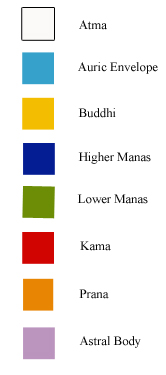Printed in the Winter 2019 issue of Quest magazine.
Citation: McDavid, Doss, "The Human Principles in Early Theosophical Literature" Quest 107:1, pg 18-25
By Doss McDavid
While students of Theosophy will be familiar with the way of describing the levels of human consciousness and the corresponding planes of nature that is pictured in diagram 1 (Jinarajadasa, 166), they may not realize that this model was the result of a gradual evolution that took place over the course of several years.

Diagram 1. Chart on the constitution of man, from C. Jinarajadasa, First Principles of Theosophy.
The first book of the modern Theosophical movement, Isis Unveiled by H.P. Blavatsky, published in 1877, presented a considerably simpler model, although she hinted at a more complex system (Blavatsky, Isis, 2:367, 588). It was the familiar threefold division of body (soma), soul (psyche), and spirit (pneuma) that was used in Platonic philosophy and early Christianity. In this scheme, the body (sometimes called sarx or flesh) is part of the material world and is therefore subject to all the limitations of time and space. It is unconditionally mortal. The spirit is part of Divinity itself and is therefore unconditionally immortal. Between these two, the third element, psyche or perispirit, is conditionally immortal. Those parts of the soul that can identify with the spirit join in its immortality, while those parts that have a greater affinity for the body are doomed to share its fate—dissolution into the elements and gradual remodeling into future life forms.
After the founders of the Theosophical Society moved to India in 1878–79, this simple threefold scheme was replaced by a sevenfold division of the human constitution. These teachings were transmitted orally from HPB to A.P. Sinnett and A.O. Hume during the late summer or early fall of 1881. Hume almost immediately began to summarize them in a series of articles called “Fragments of Occult Truth,” the first of which appeared in The Theosophist of October 1881. This series had eight parts, the first three from the pen of Hume and the last five by Sinnett. The first article described the seven principles as follows:
- The physical body, composed wholly of matter in its grossest and most tangible form.
- The vital principle (jivatma), an indestructible form of force. When disconnected from one set of atoms, it is immediately attracted by others.
- The astral body (linga sharira), composed of highly etherealized matter. In its habitual passive state, it is the perfect but very shadowy duplicate of the body, its activity, consolidation, and form depending entirely on
- The astral shape (kama rupa or body of desire), a principle defining the configuration of
- The animal or physical intelligence or consciousness or Ego. This is analogous to, though higher in degree than, the reason, instinct, memory, imagination, and similar faculties in the higher animals.
- The higher or spiritual intelligence or consciousness, or spiritual Ego, in which the sense of consciousness in the perfected man mainly resides, though the lower, dimmer animal consciousness coexists in level 5.
- The spirit, an emanation from the Absolute, uncreated, eternal. It is a state rather than a being.
Around the same time, a series of “cosmological notes” was given by the Master Morya (Chin and Barker, 510) in order to further clarify the sevenfold nature of man. This seems to have taken place in October 1881, after the Mahatma Koot Hoomi, the first Master to enter into correspondence with the two Europeans, had gone into a prolonged retreat. The English terms used by the Master to translate the Sanskrit and Tibetan words in this early list of human principles were as follows:
- Body
- Life-principle
- Astral Body
- Will-form
- Animal Soul
- Spiritual Soul
- Spirit
This terminology was used throughout the rest of the “Fragments” articles, which elaborated on the teachings given by the Mahatmas to Sinnett and Hume. In June 1883 Sinnett published Esoteric Buddhism. Many portions of this work are virtually identical to “Fragments of Occult Truth,” most of which, as we have seen, were written by Sinnett himself.
Esoteric Buddhism (65) gives the following list:
| 1. Rupa | Body | |
| 2.Prana or Jiva | Vitality | |
| 3. Linga Sharira | Astral Body | |
| 4.Kama Rupa | Animal Soul | |
| 5.Manas | Human Soul | |
| 6.Buddhi | Spiritual Soul | |
| 7.Atma | Spirit |
Esoteric Buddhism altered the nomenclature in an important way: it used the term animal soul for the fourth principle and adopted a new term, human soul, for the fifth. The sixth principle retained the designation of spiritual soul.
After its initial introduction in “Fragments of Occult Truth,” HPB and other Theosophical writers enthusiastically accepted the sevenfold classification and produced a barrage of publications promoting it. Three months after the publication of the first fragment, T. Subba Row wrote an article for The Theosophist entitled “The Aryan-Arhat Esoteric Tenets on the Sevenfold Principle in Man,” in which he showed the essential agreement between the sevenfold scheme presented in the fragments and traditional Indian philosophy (Subba Row, “Aryan-Arhat Tenets,” 93). Later on, he wrote a short article comparing the sevenfold scheme to the components of the human being in the systems of Vedanta and Taraka Raja Yoga (Subba Row, “Note to Esoteric Buddhism,” 223). In addition, a Parsi Theosophist wrote an article comparing the septenary division to the psychological analysis of the Avesta (“A Parsi FTS”). In 1886, Franz Hartmann, a medical doctor and prolific Theosophical writer, elaborated further on the septenary division and compared it to the parts of man enumerated by Paracelsus (Hartmann). Another article written during this early period was contributed by a Tibetan monk-librarian who was said to be a member of the Theosophical Society. In this article, he gives the following description of the after-death states employing the terminology used in Esoteric Buddhism:
From the dead body the other principles ooze out together. A few hours later the second principle––that of life—is totally extinct, and separates from both the human and ethereal envelopes. The third—the vital double—finally dissipates when the last particles of the body disintegrate. There now remain the fourth, fifth, sixth and seventh principles: the body of will, the human soul, the spiritual soul, and pure spirit which is a facet of the Eternal. The last two, joined to, or separated from, the personal self, form the everlasting individuality and cannot perish. . . . At the first relaxation of the will . . . the spiritual self, temporarily losing its personality and all remembrance of it, ascends to higher regions. Such is the teaching. (Blavatsky, “Tibetan Teachings,” 100–01)
One article written by HPB during this period tries to reconcile the teachings of Isis Unveiled with the system explained in the fragments (Blavatsky, “Isis Unveiled and The Theosophist,” 288). When a Theosophist pointed out the seeming contradiction between the more recent teachings affirming reincarnation and the earlier denial of this teaching in Isis, HPB provided another diagram and explained that the denial of reincarnation found in Isis pertained to the “astral monad” and not to the “spiritual monad” (see diagram 2). The “astral monad” is not ordinarily reincarnated, while the “spiritual monad” is reembodied again and again on this and other planets until it attains liberation.
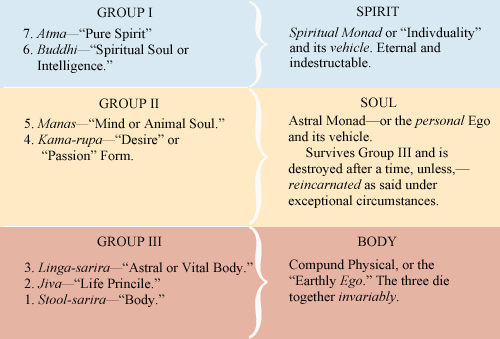
Diagram 2. A table published in The Theosophist of 1882 attempting to reconcile earlier and later versions of teachings on reincarnation. Spelling and punctuation from the original.
Another significant publication was Paradoxes of the Highest Science, which was printed in Calcutta in 1883. This book is composed of previously unpublished material by the French occultist Alphonse Louis Constant, better known as Éliphas Lévi. Hume translated it from French into English and published it with notes from K.H., using the pseudonym of “Eminent Occultist” (E.O.). In these notes, K.H. refers to the seven principles and states that “the body of man is the vehicle of the three pairs of spouses, viz. the 2nd and 3rd, the 4th and 5th, and the 6th and 7th principles ”(Lévi, 123; cf. right column of table). One of K.H.’s notes contains a table providing additional information about the human principles and showing the correspondence between the principles and the planetary rulers according to the Mandaean text called the Codex Nazaraeus. It goes as follows:
| Daemons and Principles Compared | |
|
Daemons in the |
Seven Skandhas or Principles |
| Sol. |
Spirit, the reflection of the ONE Life. |
| Spiritus (Holy Spirit), Astro (Venus) or Lebbat Amamet. |
The spiritual soul (Female). |
| Nebu (Mercury). |
The Animal Soul (Manas). |
| Sin Luna, called also Shuril and Siro. | The Kama Rupa—the most dangerous and treacherous of the principles. |
| Kiun (Kivan): Saturn. | The Life-soul, Linga sarira. |
| Bel, Jupiter (life supporter). | The Vital principle. |
| Nerig, Mars—the son of man who despoils the other sons of man; called also “Excoriatores.” |
The Gross body or material form—per se an animal, and a very ferocious and wild one. |
The sevenfold classification was not completely free from controversy. Despite his early advocacy of it, T. Subba Row soon changed his mind, calling it “unscientific and misleading” in the first of his famous 1886 series of lectures on the Bhagavad Gita (Subba Row, Notes, 13–15). He announced that in his coming lectures he would be using a psychological model based on four principles—Atma, Karanopadhi (the reincarnating ego), Sukshmopadhi (the lower psychological nature, called the astral body in these lectures, although, confusingly, it was a completely different thing from the astral body or double described in “Fragments” and Esoteric Buddhism), and Sthulopadhi (the physical body). Atma is described as the Logos or Universal Spirit, shining its radiant light through three upadhis, or vehicles, derived from different levels of differentiated material substance.
When HPB wrote a conciliatory article trying to harmonize the two views (Blavatsky, “Classification”), Subba Row refused to take yes for an answer (Subba Row, “Constitution”), requiring a further response from HPB. Reading this series of back-and-forth polemical articles is somewhat painful but instructive for serious students.
HPB’s Secret Doctrine used the septenary division of Esoteric Buddhism. With the formation of her Esoteric School in 1888, however, she explained to her pledged students that this division was not the last word on the subject. It was, she now taught, a convenient but incomplete teaching, which she was now supplementing with additional information. In her esoteric teachings, she maintained that the first and seventh principles were not actually human principles at all. The first principle (the physical body) was completely illusory and hardly worth consideration, while the seventh principle (the spirit) was so transcendental as to be outside of “man” altogether. While the earlier teachings spoke of manas (mind) as a single principle, HPB’s esoteric papers make a distinction between its higher and lower portions. Prana was not assigned a plane of its own but was explained as the manifesting aspect of Atma as the One Life. Besides these more or less familiar constituents of the human being, HPB introduced her esoteric students to a mysterious principle called the Auric Envelope and swore them to strict secrecy about it. This mysterious principle provides the invisible pattern on which the rest of the human nature is structured—from our subtlest vestures down to the grossest. It contains our link to higher worlds and preserves the karmic seeds that prevail from life to life.
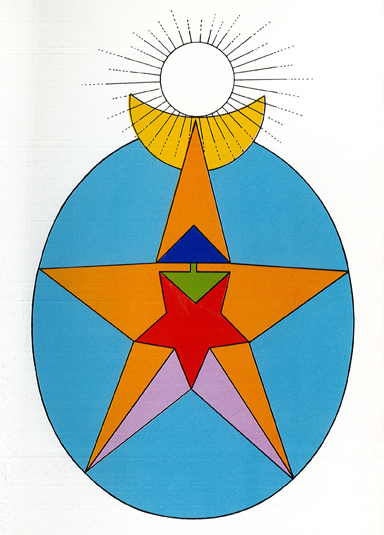 |
Diagram 3. Plate 1 from HPB's first
|
The human principles and the corresponding cosmic elements (tattvas) from which they arise were tabulated in the Esoteric Instructions as follows (Blavatsky and Caldwell, 439):
| Adi (First) Tattva | Auric Envelope |
| Anupadaka (Parentless) Tattva | Buddhi |
| Akasa (Space)Tattva | Higher Manas |
| Vayu (Air) Tattva | Lower Manas |
| Tejas (Fire) Tattva | Kama |
| Apas (Water) Tattva | Astral body |
| Prithivi (Earth) Tattva | Body in prana or animal life |
These seven principles are symbolically represented by diagram 3. In it, the Auric Envelope is represented by the blue egg, Buddhi by the yellow crescent, Higher Manas by the indigo upward-pointing triangle, Lower Manas by the green downward-pointing triangle, and Kama by the red inverted pentagram. Prana and the etheric double are represented by the orange and violet parts of the upright pentagram, the outline of which represents the physical body. Atma is represented by the shining white circle at the summit. Standing above and beyond the seven principles, it is referred to as threefold (Creator, Preserver, and Destroyer). Its link with the sevenfold man (the light of the Logos) completes the Sacred Four or Tetraktys.
In Blavatsky’s Esoteric Instructions, each of the seven human principles is correlated to one of the sacred planets, although the “moon” and the “sun” are symbols for unknown planets. The real moon—the parent of our earth—is a dead planet, while the real sun is our central star corresponding to the Atma or triple spirit in man.
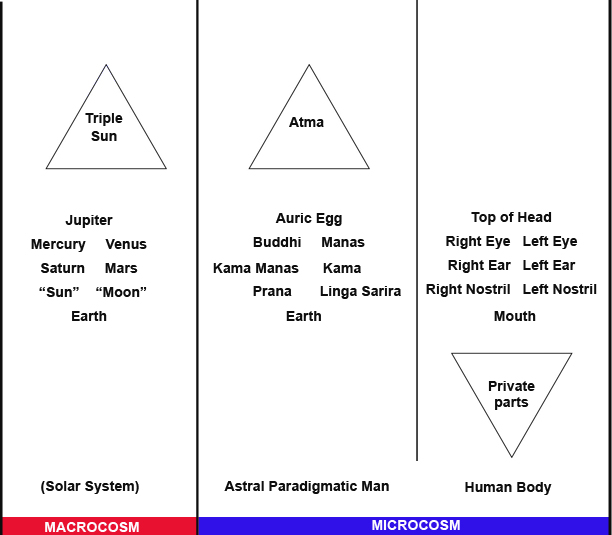
Diagram 4. Correspondences shown in HPB’s first Esoteric Instruction.
As HPB described it: “In their completeness, i.e., super-spiritually and physically, the forces are TEN: to wit, three on the subjective and inconceivable, and seven on the objective plane” (Blavatsky and Caldwell, 357). In the microcosm, the human principles correspond to parts of the physical body.
During the last years of her life, HPB continued to use the original sevenfold classification of principles in her public writings, although she hinted at the esoteric teachings. Thus, for example, in The Key to Theosophy (119–20) she hinted at the mystery of the Auric Envelope when describing the properties of buddhi:
The Spiritual Soul, Buddhi . . . conceals a mystery, which is never given to any one, with the exception of irrevocably pledged chelas, or those, at any rate, who can be safely trusted. Of course, there would be less confusion, could it only be told; but, as this is directly concerned with the power of projecting one’s double consciously and at will, and as this gift, like the “ring of Gyges,” would prove very fatal to man at large and to the possessor of that faculty in particular, it is carefully guarded.
Similarly she made a clear distinction between the lower and higher manas:
If we pass on to the Human Soul, Manas or mens, everyone will agree that the intelligence of man is dual to say the least: e.g., the high-minded man can hardly become low-minded; the very intellectual and spiritual-minded man is separated by an abyss from the obtuse, dull, and material, if not animal-minded man. . . . Every man has these two principles in him, one more active than the other, and in rare cases, one of these is entirely stunted in its growth, so to say, or paralysed by the strength and predominance of the other aspect, in whatever direction. These, then, are what we call the two principles or aspects of Manas, the higher and the lower; the former, the higher Manas, or the thinking, conscious Ego gravitating toward the spiritual Soul (Buddhi); and the latter, or its instinctual principle, attracted to Kama, the seat of animal desires and passions in man. (Blavatsky, Key, 120)
In the Key, HPB expressed the desire that Theosophists could agree on a simplified nomenclature, using English instead of the Sanskrit terminology:
To avoid henceforth such misapprehensions, I propose to translate literally from the Occult Eastern terms their equivalents in English, and offer these for future use.
The Higher Self is Atma, the inseparable ray of the Universal and One Self. It is the God above, more than within, us. Happy the man who succeeds in saturating his inner Ego with it!
The Spiritual divine Ego is the Spiritual soul or Buddhi, in close union with Manas, the mind-principle, without which it is no Ego at all, but only the Atmic Vehicle.
The Inner, or Higher “Ego” is Manas, the “Fifth” Principle, so called, independently of Buddhi. The Mind-Principle is only the Spiritual Ego when merged into one with Buddhi,—no materialist being supposed to have in him such an Ego, however great his intellectual capacities. It is the permanent Individuality or the “Reincarnating Ego.”
The Lower, or Personal “Ego” is the physical man in conjunction with his lower Self, i.e., animal instincts, passions, desires, etc. It is called the “false personality,” and consists of the lower Manas combined with Kama-rupa, and operating through the Physical body and its phantom or “double.”
The remaining “Principle” “Pranâ,” or “Life,” is, strictly speaking, the radiating force or Energy of Atma—as the Universal Life and the One Self,—Its lower or rather (in its effects) more physical, because manifesting, aspect. Prana or Life permeates the whole being of the objective Universe; and is called a “principle” only because it is an indispensable factor and the deus ex machina of the living man.
She then indulged in a little wishful thinking:
Enq. This division being so much simplified in its combinations will answer better, I believe. The other is much too metaphysical.
Theo. If outsiders as well as Theosophists would agree to it, it would certainly make matters much more comprehensible. (Blavatsky, Key, 175–76)
Following HPB’s death, Theosophists continued to adjust the terminology. In some cases, they were trying to make the original teachings more accurate and understandable. In other cases, for better or worse, they were supplementing the original teachings with their own experience.
We will now return to the diagram shown at the beginning of this article, but we will add on the right side of the diagram the principles enumerated in Mme. Blavatsky’s Esoteric Instructions to see what has happened.
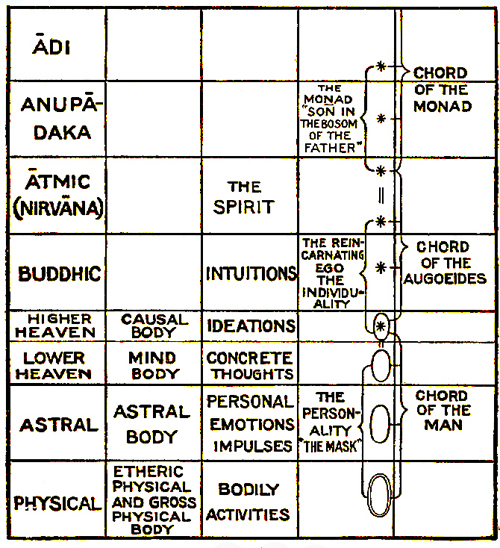 |
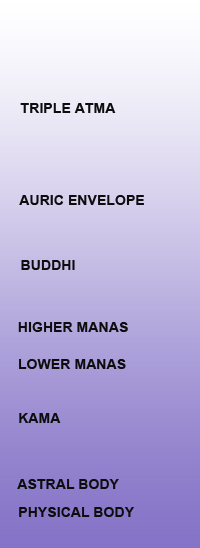 |
Diagram 5. HPB’s description of the human principles in relation to other Theosophical schemas.
Beginning with the physical plane shown at the bottom of the chart, we will move progressively to higher and higher levels as we examine the relationship between the earlier and later nomenclature. In accordance with the hint given to the Inner Group at the meeting of September 24, 1890 (Blavatsky, Inner Group Teachings, 23), the astral and physical bodies described in Esoteric Buddhism were said by the later writers of the Adyar Society (notably Annie Besant and C.W. Leadbeater) to exist on the higher and lower portions of the physical plane. These writers adopted the term etheric double or vital body to describe the part of the human being that was originally called the astral body (or linga sharira) in the earlier literature. While the dense physical body is said to draw its substance from the three lower subplanes of the physical plane (solid, liquid, and gas), the etheric double is said to be composed of four “ethers,” which make up its upper subplanes.
The double is the subtle mold on which the physical body is built during the development of the embryo. It never ordinarily goes far from the physical body, except when a portion of it is pushed out during anesthesia or is exuded as ectoplasm by spiritualistic mediums. After death, it hovers close to the decaying corpse and dissolves into its own elements.
Following the precedent set by Subba Row, the later writers consistently refer to the kama rupa as the astral body. As the seat of the animal passions and desires, it is necessary to human life but should not be allowed to have the upper hand. It is a useful servant but a dangerous master. As seen by the later writers, it exists on the seven subplanes of the astral plane.
The lower manas, or lower mental body, comes next. This is the seat of concrete mind—the outwardly directed mind that makes grocery lists, balances the checkbook, and plots to achieve the objectives of everyday life. It is our conscious, everyday, thinking mind.
After the death of the physical body, the lower mind is pulled in opposite directions by kama, holding onto earthly life, and buddhi, lifting the mind up to higher levels of consciousness. This is the “struggle” in kamaloka described in the Masters’ early letters to Sinnett (Chin and Barker, 193).
When the struggle is over, those elements of the lower manas that gravitate toward the higher mind or spiritual ego are taken into the “happy land” of devachan until it is time for a new birth. Those elements of the manas that are unfit to accompany the spirit into devachan perish along with the discarded body of desire. This is the infamous “astral shell” that can appear at spiritualistic séances, impersonating the true individuality that has passed on. It gradually dissolves into its elements, although in the case of very materialistic individuals it can remain intact as a “dweller on the threshold,” harassing the ego in a new incarnation. All these things are explained in HPB’s Esoteric Instructions.
The higher manas comes next. While the lower manas exists on the four lower subplanes of the mental plane, the higher manas exists on its three higher subplanes. The higher manas is the most concrete aspect of the causal body or reincarnating Ego, the permanent individuality that persists from life to life. This higher mind is sometimes called the thinker.
Beyond the reach and range of manas or thought, we have buddhi, the seat of intuition or direct inner knowing. According to the later writers, it exists on the fourth, or buddhic, plane.
Enveloping the entire human being is the auric envelope or auric egg. According to the later writers, it belongs to the lower subdivisions of the fifth or “nirvanic” plane, where it serves as the seat of the spiritual will (Leadbeater, 1:225). The lowest aspect of the Triple Spirit (called the Monad by the later writers) manifests on the higher levels of this same plane. The higher two aspects of the Triple Spirit or Monad exist on the two planes beyond the nirvanic. These have been called the paranirvanic and mahaparanirvanic planes and are sometimes confusingly given names that correspond to the two highest tattvas of HPB’s scheme.
This scheme, shown in diagram 5, is now more or less universal among most of the prominent writers in the Adyar Theosophical Society. It was also used by Rudolf Steiner, Max Heindel, and Alice Bailey, who were indebted to Besant and Leadbeater for their understanding of the planes and principles.
Critics of Besant and Leadbeater have accused them of making up nonexistent planes and levels of being. This is a little unfair. Their presentations were based for the most part on indications given in the Esoteric Instructions and Inner Group teachings. It is true that they changed some of the original nomenclature, but they thought they were helping the situation. The same may be said of Gottfried de Purucker, the leader of the Point Loma Theosophical Society from 1929 to 1942, with his controversial teachings about the multiple monads within the human constitution and their correlations with planets and cosmic systems, but that is a story best left for another day.
Just as HPB came to regret performing miraculous phenomena and giving too much information about her Masters, she likewise claimed to regret popularizing the septenary classification of principles. In conversation with her students in London she said the following:
Europeans ought never to have been given the seven principles. Well, perhaps in a hundred years you will understand it. It would be a thousand times better to hold to the old methods, those that I held to in Isis Unveiled, and to speak about triple man: spirit, soul, and matter; then you would not fall into . . . such heresies as you do. (Blavatsky, Secret Doctrine Dialogues, 626)
Was the popularization of the septenary division of human principles a good idea or a mistake? As modern students, living over a hundred years later, we are free to judge for ourselves!
References
Blavatsky, H.P. “Classification of Principles.” In The Theosophist 8, no. 91 (April 1887): 448–56.
———. The Inner Group Teachings of H.P. Blavatsky. San Diego, Calif.: Point Loma Publications, 1985.
———. Isis Unveiled. Two volumes. Pasadena, Calif.: Theosophical University Press, 1960 [1877].
———. “Isis Unveiled and The Theosophist on Reincarnation.” In The Theosophist 3, no. 11 (August 1882): 288–89.
———. The Key to Theosophy. Pasadena, Calif.: Theosophical University Press, 1946.
———. The Secret Doctrine. Two volumes. Pasadena, Calif.: Theosophical University Press, 1952 [1888].
———. The Secret Doctrine Dialogues. Los Angeles: Theosophy Co., 2014.
———. “Tibetan Teachings.” In Lucifer 15, nos. 85 and 86 (September and October 1894): 9–17 and 97–104.
Blavatsky, H.P., and Daniel Caldwell. The Esoteric Papers of Madame Blavatsky. Whitefish, Mont.: Kessinger, 2004.
Chin, Vicente Hao, and A.T. Barker, eds. The Mahatma Letters to A.P. Sinnett: Chronological Edition. Adyar: Theosophical Publishing House, 1998.
Hartmann, Franz. Magic, White and Black. New York: John W. Lovell, 1890.
Hume, A.O. “Fragments of Occult Truth” [part 1]. In The Theosophist 3, no. 1 (October 1881): 17–22.
Jinarajadasa, C. First Principles of Theosophy. Adyar: Theosophical Publishing House, 1960.
“A Parsi FTS,” “Theosophy and the Avesta,” The Theosophist 4, no. 1 (October 1882): 20–25.
Leadbeater, C.W. The Inner Life. Two volumes. Adyar: Theosophical Publishing House, 1917.
Lévi, Éliphas. The Paradoxes of the Highest Science. Adyar: Theosophical Publishing House, 1922.
Sinnett, A.P. Esoteric Buddhism. Boston: Houghton, Mifflin, 1884.
Subba Row, T. “The Aryan-Arhat Esoteric Tenets on the Sevenfold Principle in Man,” in The Theosophist 3, no. 4 (January 1882): 93–99.
———. “The Constitution of the Microcosm.” The Theosophist 8, no. 92 (May 1887): 504–11.
———. Notes on the Bhagavad Gita. Pasadena, Calif.: Theosophical University Press, 1978.
———. “Note to Esoteric Buddhism and Hinduism.” In The Theosophist 5, no. 9 (June 1884): 223–25.
Doss McDavid was born in San Antonio, Texas. After receiving his Ph.D. in biophysics in 1976, he was employed at the University of Texas Health Science Center at San Antonio. He retired in 2012 as professor emeritus. He holds several patents and is one of the founders of Radworks Corporation and Dental Imaging Consultants. He has been a member of the Theosophical Society since 1969 and is a member of the San Antonio branch. He served two terms on the board of directors of the American Section. His study course, An Introduction to Esoteric Principles, is available online at the TSA website and from Quest Books.


